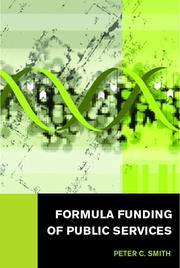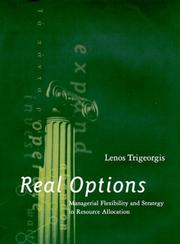| Listing 1 - 10 of 63 | << page >> |
Sort by
|
Book
ISBN: 9588307538 Year: 2009 Publisher: Washington, D.C. : The World Bank,
Abstract | Keywords | Export | Availability | Bookmark
 Loading...
Loading...Choose an application
- Reference Manager
- EndNote
- RefWorks (Direct export to RefWorks)
El diseno de transferencias fiscales intergubernamentales esta estrechamente relacionado con la eficiencia y la equidad de la prestacion de servicios publicos y con una gobernabilidad local responsable. Este libro representa una fuente integral unica de material para orientar a profesionales y expertos en el ambito del diseno y las practicas mundiales en transferencias fiscales intergubernamentales y sus implicancias para la eficiencia y la equidad en la prestacion de servicios publicos y un buen gobierno responsable. En el se exploran los temas politicos, institucionales y economicos que se enfrentan en el diseno de tales transferencias, y se combina con gran habilidad el analisis teorico con casos reales actualizados.
Accountability --- Allocation Of Resources --- Budget --- Planning --- Spanish Translation
Book
Year: 2008 Publisher: Washington, D.C. : The World Bank,
Abstract | Keywords | Export | Availability | Bookmark
 Loading...
Loading...Choose an application
- Reference Manager
- EndNote
- RefWorks (Direct export to RefWorks)
China, India y la economia mundial' da una mirada desapasionada y critica al crecimiento de estos dos paises, y postula algunas preguntas dificiles acerca de este ascenso: Donde esta ocurriendo? Quien se esta beneficiando mas? Es sostenible? Cuales son las implicaciones para el resto del mundo? A traves de seis ensayos, su principal proposito es resaltar algunas de las mayores implicaciones para la economia mundial del crecimiento de China e India. El libro examina las interacciones de estos dos paises con otros, via evolucion de sus capacidades industriales, su comercio internacional y el sistema financiero internacional, y describe posibles restricciones e influencias sobre su crecimiento (inequidad y gobernabilidad). Tambien analiza las restricciones locales y las perspectivas globales en energia y emisiones. Cada capitulo identifica un aspecto del crecimiento y discute, cuantitativa o cualitativamente, el tipo de factores que se deben considerar al proyectar su continuacion o sus efectos para determinar tendencias a mas largo plazo y ofrecer informacion al diseno de politicas durante los siguientes anos. Este libro es ademas una importante contribucion a la campana mundial para la reduccion de la pobreza. El hecho de que China e India hayan sido capaces de lograr que cientos de millones de personas salgan de la pobreza en las recientes decadas ofrece esperanza al resto del mundo.
Allocation Of Resources --- Comparative Advantage --- Global Markets --- Inequality --- Spanish Translation

ISBN: 1134229852 1280567007 9786610567003 0203013026 041536289X 0415654890 1134229844 0415511526 Year: 2007 Publisher: Taylor & Francis
Abstract | Keywords | Export | Availability | Bookmark
 Loading...
Loading...Choose an application
- Reference Manager
- EndNote
- RefWorks (Direct export to RefWorks)
The use of formulae has become widespread in recent years across most developed countries. In the UK, a conservative estimate is that annually £150 billion of public service expenditure is distributed using formulae, in services such as health care, local government, social security and higher education. This book offers a comprehensive introduction to the theory and practice underlying the use of such formulae as a basis for funding public services. The philosophy, design and economic consequences of funding formulae have become key policy issues worldwide. However, till now,
Municipal services --- Resource allocation. --- Finance. --- Allocation of resources --- Resources allocation --- Economics --- Management --- Operations research --- Organization --- Planning --- Feasibility studies --- risk --- adjustment --- case --- payment --- capitation --- payments --- mechanism --- mechanisms --- cream --- skimming
Book
ISBN: 1606506803 9781606506806 9781606506790 160650679X 160650679X 9781606506790 Year: 2015 Publisher: New York, NY : Momentum Press,
Abstract | Keywords | Export | Availability | Bookmark
 Loading...
Loading...Choose an application
- Reference Manager
- EndNote
- RefWorks (Direct export to RefWorks)
This book presents examples of engineering applications; particularly Industrial Engineering applications. Six distinct cases are included. The applications range from product design to quality control. The emphasis is on developing methodologies that can enhance utilization of resources. Case studies are important in demonstrating the use of engineering design principles and methodologies. The published literature, however, shows a paucity of cases that may be used for teaching and learning purposes. The reasons for a dearth of published case studies are many, including the propriety nature of problems and confidentiality of data. Such issues are further aggravated as many companies are self-insured and are reluctant to share information with outsiders.
Resource allocation --- Industrial engineering --- Management engineering --- Simplification in industry --- Engineering --- Value analysis (Cost control) --- Allocation of resources --- Resources allocation --- Economics --- Management --- Operations research --- Organization --- Planning --- Feasibility studies
Book
ISBN: 3030732193 3030732185 Year: 2021 Publisher: Cham, Switzerland : Palgrave Macmillan,
Abstract | Keywords | Export | Availability | Bookmark
 Loading...
Loading...Choose an application
- Reference Manager
- EndNote
- RefWorks (Direct export to RefWorks)
Macroeconomics. --- Monetary policy. --- Resource allocation. --- Allocation of resources --- Resources allocation --- Economics --- Management --- Operations research --- Organization --- Planning --- Feasibility studies --- Monetary management --- Economic policy --- Currency boards --- Money supply
Book
ISBN: 3954892804 3954897806 9783954897803 9783954892808 Year: 2015 Publisher: Anchor Academic Publishing
Abstract | Keywords | Export | Availability | Bookmark
 Loading...
Loading...Choose an application
- Reference Manager
- EndNote
- RefWorks (Direct export to RefWorks)
Since the late 1940s, linear programming models have been used for many different purposes. Airline companies apply these models to optimize their use of planes and staff. NASA has been using them for many years to optimize their use of limited resources. Oil companies use them to optimize their refinery operations. Small and medium-sized businesses use linear programming to solve a huge variety of problems, often involving resource allocation. In my study, a typical product-mix problem in a manufacturing system producing two products (each product consists of two sub-assemblies) is solved for its optimal solution through the use of the latest versions of MATLAB having the command simlp, which is very much like linprog. As analysts, we try to find a good enough solution for the decision maker to make a final decision. Our attempt is to give the mathematical description of the product-mix optimization problem and bring the problem into a form ready to call MATLAB's simlp command. The objective of this study is to find the best product mix that maximizes profit. The graph obtained using MATLAB commands, give the shaded area enclosed by the constraints called the feasible region, which is the set of points satisfying all the constraints. To find the optimal solution we look at the lines of equal profit to find the corner of the feasible region which yield the highest profit. This corner can be found out at the farthest line of equal profit, which still touches the feasible region. The most critical part is the sensitivity analysis, using Excel Solver, and Parametric Analysis, using computer software, which allows us to study the effect on optimal solution due to discrete and continuous change in parameters of the LP model including to identify bottlenecks. We have examined other options like product outsourcing, one-time cost, cross training of one operator, manufacturing of hypothetical third product on under-utilized machines and optimal sequencing of jobs on machines.
Resource allocation --- Linear programming --- Production scheduling --- Programming (Mathematics) --- Allocation of resources --- Resources allocation --- Economics --- Management --- Operations research --- Organization --- Planning --- Feasibility studies --- MATLAB. --- Microsoft Excel Solver (Computer program) --- MATLAB (Computer program) --- Matrix laboratory --- E-books --- MATLAB (Computer file)
Book
ISBN: 9781107194625 1107194628 9781316646441 1316646440 9781108161107 1108173543 1108168728 1108161103 Year: 2019 Volume: 62 Publisher: Cambridge Cambridge University Press
Abstract | Keywords | Export | Availability | Bookmark
 Loading...
Loading...Choose an application
- Reference Manager
- EndNote
- RefWorks (Direct export to RefWorks)
How to Divide When There Isn't Enough develops a rigorous yet accessible presentation of the state-of-the-art for the adjudication of conflicting claims and the theory of taxation. It covers all aspects one may wish to know about claims problems: the most important rules, the most important axioms, and how these two sets are related. More generally, it also serves as an introduction to the modern theory of economic design, which in the last twenty years has revolutionized many areas of economics, generating a wide range of applicable allocations rules that have improved people's lives in many ways. In developing the theory, the book employs a variety of techniques that will appeal to both experts and non-experts. Compiling decades of research into a single framework, William Thomson provides numerous applications that will open a large number of avenues for future research.
Scarcity --- Resource allocation --- Econometric models --- Allocation of resources --- Resources allocation --- Economics --- Management --- Operations research --- Organization --- Planning --- Feasibility studies --- Deficiency --- Shortages --- Econometric models. --- Scarcity - Econometric models --- Resource allocation - Econometric models
Book
ISBN: 0887300774 Year: 1986 Publisher: Cambridge, Mass.
Abstract | Keywords | Export | Availability | Bookmark
 Loading...
Loading...Choose an application
- Reference Manager
- EndNote
- RefWorks (Direct export to RefWorks)
Consumers --- Econometric models --- Resource allocation --- 330.115 --- Econometrics --- Mathematical models --- 330.115 Econometrie --- Econometrie --- Allocation of resources --- Resources allocation --- Economics --- Management --- Operations research --- Organization --- Planning --- Feasibility studies --- Customers (Consumers) --- Shoppers --- Persons --- Quantitative methods (economics)

ISBN: 0262285169 0585135355 9780262285162 9780585135359 026220102X Year: 1996 Publisher: Cambridge, Mass. : MIT Press,
Abstract | Keywords | Export | Availability | Bookmark
 Loading...
Loading...Choose an application
- Reference Manager
- EndNote
- RefWorks (Direct export to RefWorks)
Capital budget. --- Resource allocation. --- Capital budget --- Resource allocation --- Financial Management & Planning --- Finance --- Business & Economics --- Allocation of resources --- Resources allocation --- Economics --- Management --- Operations research --- Organization --- Planning --- Feasibility studies --- Capital budgeting --- Budget --- Capital investments --- Public investments

ISBN: 0585229988 9780585229980 9280807331 9789280807332 Year: 1990 Publisher: Tokyo, Japan United Nations University Press
Abstract | Keywords | Export | Availability | Bookmark
 Loading...
Loading...Choose an application
- Reference Manager
- EndNote
- RefWorks (Direct export to RefWorks)
Households --- Economic development --- Resource allocation --- Business & Economics --- Economic Theory --- Allocation of resources --- Resources allocation --- Economics --- Management --- Operations research --- Organization --- Planning --- Feasibility studies --- Population --- Families --- Home economics --- Economic aspects --- Congresses --- Research
| Listing 1 - 10 of 63 | << page >> |
Sort by
|

 Search
Search Feedback
Feedback About UniCat
About UniCat  Help
Help News
News